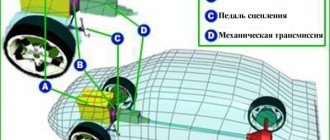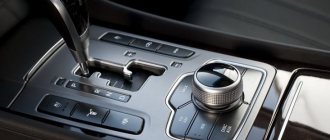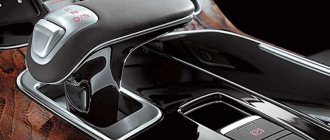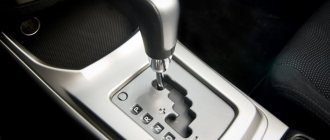One of the main signs of a “deteriorating health” of an automatic transmission, which every owner of a car with an automatic transmission can “feel” is a change in the automatic transmission shifts, the appearance of jolts, jerks or “jerking”.
From this article you will learn:
- Why does the automatic transmission start shifting gears with jerks or jerks?
- Shocks due to cold
- Shocks due to late oil change
- Shocks due to low oil level
- “Non-standard” reasons for automatic transmission jolts
- Is it possible to “cure” automatic transmission kicks?
- Automatic transmission breakdown detection
- I checked all the reasons - it didn’t help
On almost any serviceable modern automatic transmission, the gear shifting process occurs quite quickly and is almost imperceptible to the driver.
Therefore, any changes in automatic transmission switching should cause the owner at least wariness, or better yet, a desire to call in a service center for diagnostics.
Shocks due to cold
The first common reason that can cause shocks when switching automatic transmissions is low temperature.
If the transmission fluid is not warmed up enough (at sub-zero temperatures), almost any automatic transmission may “kick” for some time after starting to move. However, as the box warms up, all shocks during switching should disappear (if they remain, it is better not to delay a trip to the service center for diagnostics).
Driving on unheated oil in an automatic transmission is actually quite harmful for the gearbox, since any automatic transmission is designed to operate on oil that has certain physical properties. Low temperatures change the properties of the oil, which is why some automatic transmission elements begin to experience overload.
You should not abuse the quick start of movement immediately after starting the engine in winter in a car with an automatic transmission - it is advisable to warm up the car for at least some time. Regular trips with unheated automatic transmission oil can lead to serious damage to the gearbox.
Jerking when braking (software problems)
Sometimes the automatic transmission kicks when the driver presses the brake. This is usually due to problems with the unit's software.
Causes
The appearance of kicks during braking may be due to problems with the software used to control the transmission system.
Remedy
It is unlikely that you will be able to solve this problem on your own. To eliminate it, you will need to reinstall the control automation, in particular , perform a firmware update. But doing it yourself is not so easy. If the car is still under warranty, then you should definitely seek help from representatives of the dealer company.
The video shows the process of flashing an automatic transmission unit using the example of a VW Tiguan (material published by the SBll channel).
Practice shows that new automatic transmissions often require updates. Thanks to this, it is possible to achieve not only elimination of kicks, but also optimization of the operation of the transmission as a whole. Before flashing, representatives of the dealer company perform a complete computer diagnostics of the vehicle.
Shocks due to late oil change
The second most common cause of jerks when switching automatic transmissions is dirty oil. When the transmission fluid is contaminated above a certain limit, its physical properties begin to change, which can lead to “jerking” when shifting gears.
Constant operation of the automatic transmission on dirty oil also leads to overload of certain elements of the box, which can lead to serious damage. That is why each automatic transmission has its own scheduled oil change periods, which can be reduced under difficult operating conditions.
Separately, it is worth noting the operation of the machine on dirty oil at low temperatures. Under these conditions, the box experiences longer overloads, since dirty oil loses the necessary physical properties noticeably earlier than clean oil, which shortens the service life of the automatic transmission. To prevent the automatic transmission from operating with “maximum” overloads - due to dirty oil and at low temperatures - many car owners prefer to change the oil and filter in the automatic machine in the fall, preparing the box in advance for use in cold weather.
How to change it?
Note that there are two ways to carry out this operation: partial or complete replacement of ATP fluid. The first method is used when doing work with your own hands. A complete replacement is done at a specialized stand in a service station. Which method is better to choose? At first glance, there is nothing better than a complete replacement. But, as practice shows, after such an operation the kicks can even get worse. The fact is that when replacing under pressure, the device expels all the waste products that have previously rubbed into the disks and other elements. And if previously, when the automatic transmission was engaged in gear, the car did not jerk much, then after this work a noticeable shock is felt. Therefore, it is better to use the partial replacement method. It involves draining liquid from the pan. The latter is also dismantled - inside it there are magnets with chips that should be removed.
Next, new fluid is filled to the maximum. And after a run of a thousand kilometers, this operation is performed again. The result is the disappearance of kicks and more stable operation of the automatic transmission. And in order to avoid having to deal with transmission repairs in the future, it is recommended to change the ATP fluid every 60 thousand kilometers. But it is worth noting that changing the oil is not always an ironclad method for solving the kicking problem. There are many more reasons why the car jerks when you engage a gear in an automatic transmission.
Shocks due to low oil level
The third reason that can make the machine “twitch” is the low oil level in the box.
The oil in an automatic transmission is the working fluid, thanks to which gear shifts occur, so its quantity in the box must be sufficient.
Sometimes it happens that the level can drop below o, and the owner does not have time to notice it. The reasons are simple - the oil in the machine may leak, or when replacing it, the technician may “forget” to set the required level.
One way or another, you need to monitor the oil level in the box and if it becomes lower than required, add oil to the automatic transmission.
Transmission solenoids and valve body
The hydraulic unit is a kind of plate, inside of which there are many channels. It is through them that oil flows under pressure. Each channel leads to its own speed. When oil is supplied under pressure, a certain package of disks begins to expand and contract. This is how the transition from low to high gear and vice versa occurs. But if the channels in the plate become clogged, there will not be enough pressure to control the clutches. As a result, the automatic transmission jerks when the gear is engaged. Whether it is a Toyota Camry or a Mercedes E-Class does not matter, since the root of the problem is the same. This problem can be solved by disassembling the hydraulic plate and mechanically cleaning it.
“Non-standard” reasons for automatic transmission jolts
In addition to the reasons described above, the behavior of the automatic transmission can also be influenced by some “non-standard” reasons. For example, many car owners may mistake shocks that occur due to the “adaptiveness” of the box as a malfunction. Most modern automatic transmissions are able to adapt to the driver's driving style - shift gears depending on his actions on the road.
If the driver, for example, drives the last few kilometers quickly - brakes sharply and accelerates sharply - then the automatic transmission, “adjusting” to his driving, tries to engage gears “in the red zone of the tachometer,” allowing the full engine power to be used.
And if the driver is driving slowly, the automatic transmission tries to shift to a higher gear faster, which helps save fuel.
Which gear needs to be engaged at what point in time is decided by the ECU - the electronic control unit of the box, which constantly collects and analyzes information about all modes of vehicle movement.
When “transitioning” from one driving mode to another - for example, from “fast” to “leisurely” - the ECU may engage gears somewhat incorrectly, which can cause shocks when switching the automatic transmission.
Another reason that may influence the behavior of some is low-quality fuel, which is often found at gas stations in Russia.
So, for example, the car drove the last 500 km on relatively good gasoline, and after refueling at a “nameless” gas station, the tank contained “dirty” gasoline, due to which the engine began to run unevenly. Such a “failure” in the smooth operation of the engine can also affect the operation of the automatic transmission and cause jolts when changing gears.
Quick diagnostics
So, the car is started, the speed is turned on, the clutch is slowly released, and the engine speed gradually increases.
But instead of smoothly starting from a stop and starting to pick up speed, the car begins to jerk - the speed fluctuates, the speed either increases or drops sharply, despite pressing the accelerator pedal.
This can continue until either the twitching goes away on its own and the car begins to confidently gain momentum, or until the engine stalls.
It happens that the car starts moving quite safely, but as soon as the revolutions increase to 2000-2500, uneven movement begins, accompanied by sharp changes in engine operation, as well as in the speed of movement.
The same situation can be observed when reaching medium modes, that is, the engine reaches a certain speed level, after which twitching begins.
It happens that the car starts to jerk every time you change gears.
It is not necessary that uneven running occurs only under certain conditions.
It also happens that the car jerks spontaneously, without any frequency or conditions. That is, the car can jerk just once, in any mode, and then move normally for quite a long time.
Or the car was working normally, but suddenly began to twitch sharply, and this trouble no longer goes away.
In general, there are a lot of options, but one fact remains - the car has an uneven ride, and it is advisable to eliminate it as quickly as possible before the problem gets worse.
The first thing to do is determine under what conditions the twitching occurs. The easiest way to do this is while moving.
You should drive onto a flat section of the road where there is no traffic and start testing.
At first, just get moving, then gradually increase the speed, remembering the behavior of the car and watching the dashboard.
And this must be done until the engine reaches high speeds.
Afterwards, you will need to run the test again to make sure that the conditions for the appearance of twitching are determined correctly. And only after that you can start looking for the reason.
A summary table of the reasons why the car jerks for different types of motors for quick diagnosis.
| Causes | Car jerking while driving | |||
| Injector | Carburetor | On gas | Diesel | |
| The carburetor is clogged or faulty (clean, repair, replace) | — | + | — | — |
| Fuel and air filters are clogged (replace) | + | + | + | + |
| Gas filter clogged (replace) | — | — | + | — |
| Dirty injectors (clean, replace) | + | — | + | + |
| Malfunctions in the ignition system (check for serviceability of spark plugs, ignition coil, high-voltage wires) | + | + | + | — |
| Excess air enters the intake manifold, which is not taken into account by the ECU (identify and eliminate air leaks) | + | + | + | + |
| The TPS or throttle actuator has failed*** Examine the symptoms of a malfunctioning throttle position sensor. | + | — | + | — |
| Malfunction of sensors responsible for engine speed: Idle air control, absolute pressure sensor, mass air flow, accelerator, coolant temperature sensor. | + | — | + | +* |
| The contact point of the crankshaft sensor (crankshaft sensor) has failed or become clogged. | + | -/+**** | + | +* |
| Fuel pump malfunction | + | + | — | — |
| Problems in the operation of the injection pump (high pressure fuel pump), life expired, breakdown | -/+** | — | -/+** | + |
| Problems with the gas reducer | — | — | +/-** | — |
| Freezing of the gearbox or lines | — | — | + | — |
| Clutch wear, incorrect adjustment | + | + | + | + |
| Transmission problems (manual transmission, automatic transmission, CVT, robot) | + | + | + | + |
| Problems in the operation of the elements of the cylinder-piston group (failure in valve adjustment or malfunction, breakdown of hydraulic compensators) | + | + | + | + |
| Fuel that does not meet the requirements of the car manufacturer, its low quality | + | + | + | + |
* applies only to diesel engines that have a Common Rail injection system.
** applies to vehicles equipped with direct injection engines and 6th generation LPG with liquid gas injection installed on them.
*** for cars with an injection system equipped with an electronic e-gas pedal.
**** for carburetors of cars with an electronic ignition system.
Is it possible to “cure” automatic transmission kicks?
The vast majority of problems with automatic transmissions are somehow related to the quality or quantity of transmission fluid. Therefore, their elimination in most cases is associated with bringing the working fluid of the box to normal condition.
It often happens that the box operates on transmission fluid, with physical properties different from those laid down by the developers, for quite a long time. Long-term operation of an automatic transmission in such conditions leaves a mark on the “health” of the box - the box noticeably wears out, although this may not be noticeable to the driver.
For such automatic transmissions, a simple oil change may no longer be sufficient to eliminate shocks during operation. As an option to “treat” such an automatic transmission, you can try adding a special additive to the oil - an additive that will change the physical properties of the oil.
You can find a lot of all kinds of additives for automatic transmissions on sale, but few of them can actually positively affect the operation of the box.
For example, the tribotechnical composition “Suprotek” has proven itself very well, providing the components and assemblies of the car with noticeably more stable operation and an additional protective layer (not advertising, personal experience of those who have tried it). It is also worth noting that this additive, developed in Russia, is purchased en masse by the Ministry of Defense of the Russian Federation as a composition that increases the survivability of military equipment.
For example, you can buy Suprotek for automatic transmissions inexpensively and with delivery here >>>>
Does it kick when it's cold or hot?
It happens that the automatic transmission kicks and jerks at all speeds or when shifting from 1 to 2. You need to figure out whether it kicks when it's hot or when it's cold.
Causes
It does not matter whether this problem occurs when starting off or when driving at low speeds. The reasons for this behavior of the unit are usually the following:
- There is a lack of transmission oil in the system.
- The substance used for lubrication has lost its technical properties and has become of low quality.
- Problems have appeared in the operation of the main unit of the unit - the torque converter. In particular, we are talking about difficulties in the functioning of the blocking device.
Remedy
Problems of this kind can be eliminated in several ways:
- Add lubricant to the transmission system. You need to find the inspection and filler holes on the gearbox, fill in the fluid so that it meets the standard. It is advisable not to overfill it.
- If the problem lies in quality, the lubricant must be replaced. When draining, pay attention to the condition of the substance. If there are traces of deposits and dirt in it, then it makes sense to wash the box. Otherwise, the unclean oil that remains in it will mix with the new one. Accordingly, fresh lubricant will also lose its properties in the near future.
- Problems with the operation of the blocking device are resolved by computer checking the unit.
The video below will allow you to learn more about the torque converter lock-up device, as well as malfunctions that can occur in its operation. The material was filmed and published by Dmitry Yakovlev.
Automatic transmission breakdown detection
On most modern cars, in the event of shocks or twitching of the automatic transmission, error codes are recorded in the memory of the on-board computer, which display certain malfunctions that occur with the car. As a rule, along with the appearance of errors, the “Check engine” warning light lights up on the dashboard.
However, there are cases when, when errors appear, the car’s on-board computer does not consider this error to be a serious enough breakdown, or this error appears and disappears, the computer does not turn on the “Check engine” warning light. That is, the car owner cannot understand whether there are any errors currently in the memory of the on-board computer and whether they could be the cause of automatic transmission jolts.
In this case, the car owner needs to read errors from the memory of the car’s on-board computer and decipher them. This can be done at almost any car service for money, or independently, using a special error scanner.
There are convenient universal car adapters that will help you read errors on any car using a regular smartphone. Such an adapter can significantly save time and money for the car owner (on car diagnostics). For example, the ELM-327 adapter is very convenient and popular, which can be ordered with home delivery.
The next step will be to decipher the error code and determine whether it affects the operation of the automatic transmission. Error codes for each car model can be found freely available on the Internet.
I checked all the reasons - it didn’t help
If, after checking all the reasons described above, there is still no one that interferes with the normal operation of the automatic transmission, then it’s time to go to a good service center to diagnose the transmission, and the sooner the better.
In a good service, diagnostics are relatively inexpensive, and qualified technicians can easily express thoughts about the causes almost immediately, which can prevent further development of the breakdown and significantly increase the chances of inexpensive repairs. For example, very inexpensive diagnostics in the VilGud car service network >>>











